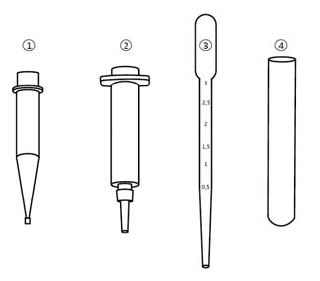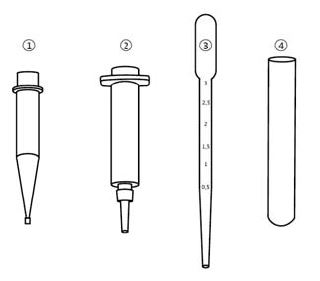HAT mAECT KIT, collector tube + mini-column + pipette + tube
Valid Article
HAT mAECT KIT, mini-column
Definition
The mini anion exchange centrifugation technique (mAECT) is used for the detection of trypanosomes (Human African Trypanosomiasis).
It consists of separating the trypanosomes from venous blood by anion exchange chromatography and concentrating them in the bottom of a transparent tube by centrifugation (3000 rpm). After centrifugation, the tip of the transparent tube is examined under the microscope for the presence of mobile trypanosomes.
Specifications
Components
One kit contains:
- 20 mini-column with 2 stoppers per column
- 20 collector tubes with blue stopper
- 20 plastic graduated transfer pipettes
- 20 centrifuge tubes
- instruction leaflet
Technical specifications
- Set to perform 20 tests
- High sensitivity: 500 µl of blood allows detection of less than 50 trypanosomes/ml
- Mini-column (2)
- plastic
- single use, sterile
- grey rubber upper stopper
- white lower stopper
- used to separate blood from tryponasomes by anion exchange chromatography
- Collector tube (1)
- transparent plastic
- blue stopper
- non sterile, single use
- Transfer pipette (3)
- transparent plastic
- graduated
- non sterile, single use
- Centrifuge tube (also called 'waste tube') (4)
- round bottom, 14 ml
- plastic
- non sterile
Packaging & Labelling
Kit including different components (see above)
Articles to be ordered separately:
- mAECT viewing chamber
- mAECT column/tube rack
- mAECT column opener
- microscope with 10x objective and 10x or 15x ocular
- latex gloves
- micropipette for 500 µl with pipette tips
- waste container
- detergent-disinfectant solution
- electrical centrifuge
Instructions for use
- Follow the instructions of the package insert.
- Open only the minicolumns and collector tubes just before use, in order to avoid any contamination.
- Trypanosomes are fragile. Blood should be examined as soon as possible, no later than 30 minutes after collection.
- Use latex gloves for blood sampling and test performance.
- Use the heparin lithium tubes for blood sampling. Do not use EDTA or citrate as anticoagulant.
Maintenance
In case the device needs to be reused, it must be cleaned and disinfected with a 0.5% detergent-disinfectant solution for medical equipment (i.e. 25 ml = 1 stroke of dosing pump for 5 litres water).
(Cf Introduction: Disinfection and sterilization in the field)
Storage
- Store mini-columns at 4°C
- Do not freeze the mini-columns
- Shelf life columns: 2 years
Waste management
Destroy waste material properly after use by incineration.
MSF requirements
Easy to use technique to concentrate the trypanosomes in blood samples with high sensitivity. Despite logistical needs, it is necessary for sensitive diagnosis of HAT.
Can be performed in MSF trypanosomiasis programmes and is necessary for diagnosis of HAT with maximum sensitivity.





![[ELABHATR1--] HAT MODIFIED SIMPLE CENTRIFUGATION KIT, LCR](/web/image/product.template/570343/image_256/%5BELABHATR1--%5D%20HAT%20MODIFIED%20SIMPLE%20CENTRIFUGATION%20KIT%2C%20LCR?unique=ed12974)
![[ELABHATR101] (HAT MSC/mAECT) READING CHAMBER](/web/image/product.template/570344/image_256/%5BELABHATR101%5D%20%28HAT%20MSC-mAECT%29%20READING%20CHAMBER?unique=0dff241)
![[ELABHATR102] (HAT mAECT) RACK FOR MINI-COLUMNS, TUBES](/web/image/product.template/570355/image_256/%5BELABHATR102%5D%20%28HAT%20mAECT%29%20RACK%20FOR%20MINI-COLUMNS%2C%20TUBES?unique=0dff241)
![[ELABHATR103] (HAT mAECT) COLUMN OPENER](/web/image/product.template/570356/image_256/%5BELABHATR103%5D%20%28HAT%20mAECT%29%20COLUMN%20OPENER?unique=538bcf4)
![[ELABPIAA1000] PIPETTE, AUTOMATIC, adjustable vol. 100-1000 µl (Eppendorf)](/web/image/product.template/568917/image_256/%5BELABPIAA1000%5D%20PIPETTE%2C%20AUTOMATIC%2C%20adjustable%20vol.%20100-1000%20%C2%B5l%20%28Eppendorf%29?unique=b7c1b7e)
![[ELABPIATB--] (aut.pip.) TIP BLUE, 50-1000µl (Eppdf)](/web/image/product.template/570970/image_256/%5BELABPIATB--%5D%20%28aut.pip.%29%20TIP%20BLUE%2C%2050-1000%C2%B5l%20%28Eppdf%29?unique=a14d948)
![[ELABTUCE1NP] TUBE, CENTRIFUGE, 15 ml, conical bottom, plastic](/web/image/product.template/571485/image_256/%5BELABTUCE1NP%5D%20TUBE%2C%20CENTRIFUGE%2C%2015%20ml%2C%20conical%20bottom%2C%20plastic?unique=476fee2)
![[ELAECENE9--] CENTRIFUGE, electrical (Hettich EBA 200), 8 tubes, 230V](/web/image/product.template/572068/image_256/%5BELAECENE9--%5D%20CENTRIFUGE%2C%20electrical%20%28Hettich%20EBA%20200%29%2C%208%20tubes%2C%20230V?unique=299942e)
![[ELAEMICE6B-] MICROSCOPE (PrimoStar 3 iLED), light & fluorescence 100-240V](/web/image/product.template/581621/image_256/%5BELAEMICE6B-%5D%20MICROSCOPE%20%28PrimoStar%203%20iLED%29%2C%20light%20%26%20fluorescence%20100-240V?unique=65e3459)
![[SMSUGLOE1M-] GLOVE, EXAMINATION, latex, s.u. non sterile, medium](/web/image/product.template/568750/image_256/%5BSMSUGLOE1M-%5D%20GLOVE%2C%20EXAMINATION%2C%20latex%2C%20s.u.%20non%20sterile%2C%20medium?unique=5ce0072)
![[STSSBSVT2HL] (blds.syst.) TUBE, VACUUM, plastic, Li-HEPARIN, 2 ml green](/web/image/product.template/570347/image_256/%5BSTSSBSVT2HL%5D%20%28blds.syst.%29%20TUBE%2C%20VACUUM%2C%20plastic%2C%20%20Li-HEPARIN%2C%202%20ml%20green?unique=d71edb7)
![[STSSBSVT5HL] (blds.syst.) TUBE, VACUUM, plastic, Li-HEPARIN, 4 ml green](/web/image/product.template/570523/image_256/%5BSTSSBSVT5HL%5D%20%28blds.syst.%29%20TUBE%2C%20VACUUM%2C%20plastic%2C%20%20Li-HEPARIN%2C%204%20ml%20green?unique=329bed2)